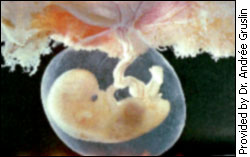| Researchers
find gene
that causes miscarriages
By Rebecca Lau
OTTAWA —
As an obstetrician, Dr. Andrée
Gruslin is repeatedly discouraged by the lack of scientific
advancement that can help patients with high risk pregnancies.
As a researcher with the Ottawa Health Research Institute,
she's developing the very studies that may one day prevent
miscarriages and stillbirths.
 |
| Scientists may soon be able to
predict whether a woman will have a high risk pregnancy. |
"I only see those with complications
and it's very frustrating for the parents and for us
that look after these mothers to not be able to identify
that there's going to be a problem ahead of time,"
she says.
"And more importantly, not be able
to treat them," she adds.
Gruslin and her colleagues published a
highly publicized study this past summer that indicated
a malfunctioning enzyme may cause women to carry small
fetuses. Abnormally small fetuses, which can cause fetal
death, are caused by a condition known as fetal growth
restriction. In these cases, the placentas don't develop
normally and the fetus is unable to properly receive
nutrients and oxygen. Gruslin says if the fetuses do
survive, the babies often have "a slew of complications"
for life.
"They were programmed differently
when they were fetuses and that makes them more prone
to be diabetic, hypertensive and have heart disease."
Searching for an answer
Gruslin says very little is known about
the placenta and its mechanisms for growth. Her research
team hoped to answer the mystery of fetal growth restriction
by targeting the molecule IGF-II, which acts as a growth
factor for the placenta.
Scientists knew that in order for IGF-II
to make tissues grow, it had to be cut into three small
pieces. What they didn't know was - what cut it?
"We didn't know the [enzyme] that
does the last cut at the end that result in the activation
of the growth factor."
| 'Perhaps in five
to 10 years from now, we'll be able to use gene
therapy.' |
Gruslin and her colleagues reasoned that
the correct enzyme might be PC4 because the amino acids
that constitute the structure of IGF2 can be recognized
by this enzyme However, previous research concentrated
only on the presence of PC4 in the ovaries and testes.
By looking at a sample of human placentas, the researchers
were able to locate PC4 in the placenta as well. Even
more significantly, it was shown in test tubes that
PC4 did indeed cut IGF-II.
The team then set up an artificial invasion
assay with IGF-II, PC4 and an inhibitor of PC4 to test
the significance of the enzyme in the placenta's development.
Invasion happens when placenta cells invade the uterus
penetrate the muscle to bring blood and oxygen to the
embryo. IGF-II is the growth factor that aids invasion.
When the process is hampered by inactive IGF-II, the
placenta is improperly developed and the fetuses become
small.
The artificial invasion model showed a
decrease of invaded cells when the PC4 was not allowed
to act properly because of the addition of an inhibitor.
By testing blood from fifteen women in the later stages
of pregnancy, the team saw that women with small babies
had less cut pieces of IGF-II and presumably had malfunctioning
PC4. On the other hand, expectant mothers with normal
fetuses had a large number of cut IGF-II pieces.
"So all of that put together allowed
us to say that probably this enzyme in this gene is
important in ensuring the placenta grows normally,"
Gruslin says.
Looking to the future
Due to their findings, researchers hope
that they might be able to create a test to predict
whether women will have fetal growth restriction. The
team is now verifying their results with lab mice that
have no PC4. They will also test a larger sample of
pregnant women.
| 'You feel so helpless
to not be able to do anything about it.' |
"Perhaps in five to 10 years from
now, we'll be able to use gene therapy. So, if you knew
that your PC4 was not working well, then maybe we could
put in or drive the PC4 gene to make it work better."
But currently, Gruslin says testing is
a more realistic goal. She says women who are flagged
as risks can then be watched closely for complications
or have their babies delivered early to prevent fetal
deaths.
Gruslin says fetal growth restriction
is not a highly researched area and can be overlooked
when it comes to grants and funding.
She says a major driving force in her
research is her patients, one of whom suffered eight
consecutive miscarriages.
"It really motivates you to keep
going because it's just horrible. It’s really
dreadful," she says. "You feel so helpless
to not be able to do anything about it. It stimulates
you a lot to keep going back in the lab."
|